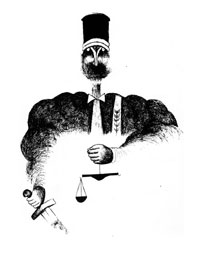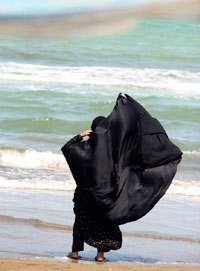Infrequent Millions contributor Buzz Poole has written for numerous publications and is the author of Madonna of the Toast. He is also the proprietor of a blog by the same name.
The scene: an all-night, drug-fueled party. We could be in New York, London, Berlin or Buenos Aires, until the host turns down the music, telling revelers “Be quiet, or we won’t be able to hear it – it should be coming now!” People laugh knowingly and accuse the host of being disrespectful, but then at 5 a.m. comes the Azan, the first call to prayer:
A high-pitched male voice, singing in Arabic, soars through the air. The crowd begins to cheer, whistle and clap. Then the music is turned back up and the party continues.
Such is life on the Persian hip-hop scene – one of the many examples of how the global influences of the 21st century have fused with tradition in Iran.
 Transit Tehran: Young Iran and Its Inspirations provides myriad ways to trace the contradictions and dichotomies that define contemporary Iran, especially in Tehran. Fiction, nonfiction, photography, film stills, paintings and illustrations speak to every aspect of the capital’s 14 million residents, while also exploring the burden that artists bear as “cultural agents to the West,” in the words of contributor Shirin Neshat. These potent and incisive creative acts and cultural investigations are complicated by the current government’s imposing role in controlling the flow of information in and out of the country. But it is not only the Islamic Republic that has used authoritarian tactics to maintain power over its people. Transit Tehran presents Islam as just one of many aspects of the country today, reaching back to Persian history, kings, shahs, the influence of foreign governments and oil.
Transit Tehran: Young Iran and Its Inspirations provides myriad ways to trace the contradictions and dichotomies that define contemporary Iran, especially in Tehran. Fiction, nonfiction, photography, film stills, paintings and illustrations speak to every aspect of the capital’s 14 million residents, while also exploring the burden that artists bear as “cultural agents to the West,” in the words of contributor Shirin Neshat. These potent and incisive creative acts and cultural investigations are complicated by the current government’s imposing role in controlling the flow of information in and out of the country. But it is not only the Islamic Republic that has used authoritarian tactics to maintain power over its people. Transit Tehran presents Islam as just one of many aspects of the country today, reaching back to Persian history, kings, shahs, the influence of foreign governments and oil.
 Many of the stories and studies in this book hinge on the dilemma of change without change, which according to Neshat dates back to the nineteenth century. “[T]he tragedy of Iran seems to repeat itself, with no escape,” he writes, in an appreciation of the exiled illustrator Aredeshir Mohassess. Living in New York since 1976, Mohassess is considered “the most significant living Iranian artist to date… almost entirely forgotten by both the Iranian and the Western public.” The strength of Mohassess’s work, as Neshat sees it, is that it “facilitates an understanding of the modern political history of Iran, from the nineteenth to the twenty-first centuries: a history that proves to be overwhelmingly dark and authoritarian.” Of the black ink samplings of Mohassess’s illustrations in Transit Tehran, chains figure heavily, rendering forced servitude, almost always at the hands of government figures. But just as this work alludes to a bloody history of exploitation, the resilient and revolutionary spirit of the people is celebrated with macabre humor. The illustration “The king is always above the people,” for example, comprises a group of modest men, with their king strung up above them.
Many of the stories and studies in this book hinge on the dilemma of change without change, which according to Neshat dates back to the nineteenth century. “[T]he tragedy of Iran seems to repeat itself, with no escape,” he writes, in an appreciation of the exiled illustrator Aredeshir Mohassess. Living in New York since 1976, Mohassess is considered “the most significant living Iranian artist to date… almost entirely forgotten by both the Iranian and the Western public.” The strength of Mohassess’s work, as Neshat sees it, is that it “facilitates an understanding of the modern political history of Iran, from the nineteenth to the twenty-first centuries: a history that proves to be overwhelmingly dark and authoritarian.” Of the black ink samplings of Mohassess’s illustrations in Transit Tehran, chains figure heavily, rendering forced servitude, almost always at the hands of government figures. But just as this work alludes to a bloody history of exploitation, the resilient and revolutionary spirit of the people is celebrated with macabre humor. The illustration “The king is always above the people,” for example, comprises a group of modest men, with their king strung up above them.
Khosrow Hassanzadeh’s series of paintings “Guys in the Hood,” inspired by his desire “to remind people that although the Revolution happened, in many ways, beneath the surface, nothing changed,” features such modest men. His subjects are his neighbors, who enjoy long-standing pastimes like waterpipes, wrestling and chai. Proud, assured faces define these portraits, which derive from martyrs’ portraits and the fact that the “government still says the Iranian people are living martyrs; sixty million people ready to die for their ideology.”
 Women are the focus of several of the pieces in Transit Tehran. Newsha Tavakolian’s “Girl Power” photographs convey “one of the many contradictions of life here. The new generation [of women] is completely different from that of their mothers who just ran households.” This difference ranges from attending university and running businesses to martyrdom, but even the empowerment generated by these changes does not eradicate the patriarchic reality of the culture at large. “Dragnet Tehran” introduces Iranian policewomen, in existence as trainees since 1966 but only just making their “first official public appearance during the 2006 demonstration on International Women’s Day.” “Going Home,” perhaps the most personal offering in the book, eulogizes the pre-Revolution days when women would wear bathing suits in the Caspian Sea. Javad Montazeri’s images of women enjoying a day at the beach and swimming in the hejab were shot for his daughter, who will also have to cover herself when she turns nine years old: “The change that has taken place didn’t evolve naturally. It was imposed on us… They altered surface appearances, but people’s minds were unaffected.”
Women are the focus of several of the pieces in Transit Tehran. Newsha Tavakolian’s “Girl Power” photographs convey “one of the many contradictions of life here. The new generation [of women] is completely different from that of their mothers who just ran households.” This difference ranges from attending university and running businesses to martyrdom, but even the empowerment generated by these changes does not eradicate the patriarchic reality of the culture at large. “Dragnet Tehran” introduces Iranian policewomen, in existence as trainees since 1966 but only just making their “first official public appearance during the 2006 demonstration on International Women’s Day.” “Going Home,” perhaps the most personal offering in the book, eulogizes the pre-Revolution days when women would wear bathing suits in the Caspian Sea. Javad Montazeri’s images of women enjoying a day at the beach and swimming in the hejab were shot for his daughter, who will also have to cover herself when she turns nine years old: “The change that has taken place didn’t evolve naturally. It was imposed on us… They altered surface appearances, but people’s minds were unaffected.”
The Western media tends to cover only certain aspects of Iran, creating a perception that these alone define the country. For those of us on the outside looking in, every page of Transit Tehran peels away a layer of misunderstanding and sheds light on the dynamics of Iran and its people.
Update: It’s been brought to our attention that the Transit Tehran’s co-editor, Maziar Bahari, has been imprisoned in Tehran since June 12. PEN issued a letter last week, signed by a who’s who of contemporary writers, demanding his release
[Images courtesy Garnet Publishing]








